-
01-01-2016
Leads for potentializing groups in Primary Health Care
Revista Brasileira de Enfermagem. 2016;69(5):964-971
Abstract
Leads for potentializing groups in Primary Health Care
Revista Brasileira de Enfermagem. 2016;69(5):964-971
DOI 10.1590/0034-7167-2015-0102
Views0See moreABSTRACT
Objective:
to analyze the aspects that potentialize groups in Primary Health Care according to their coordinators and participants.
Method:
This is a descriptive study with a qualitative approach, conducted with a health promotion group affiliated with a Family Health Unit. The data were collected by means of focus groups with participants and community workers who were submitted to thematic content analysis.
Results:
the analysis gave rise to three thematic categories: The group is our medicine; Healthy living and learning; and Priceless leadership.
Conclusion:
the leads identified during the study were as follows: group organization involves investment in motivation and leadership by the coordinators; production of grouping and cohesion is a result of participants and coordinators meeting together, interspersed with dialog, things said and left unsaid that the subjects expressed in the group dynamic; the sense of belonging guarantees their placement in the group based on the recognition of their knowledge and affective, social and health needs.
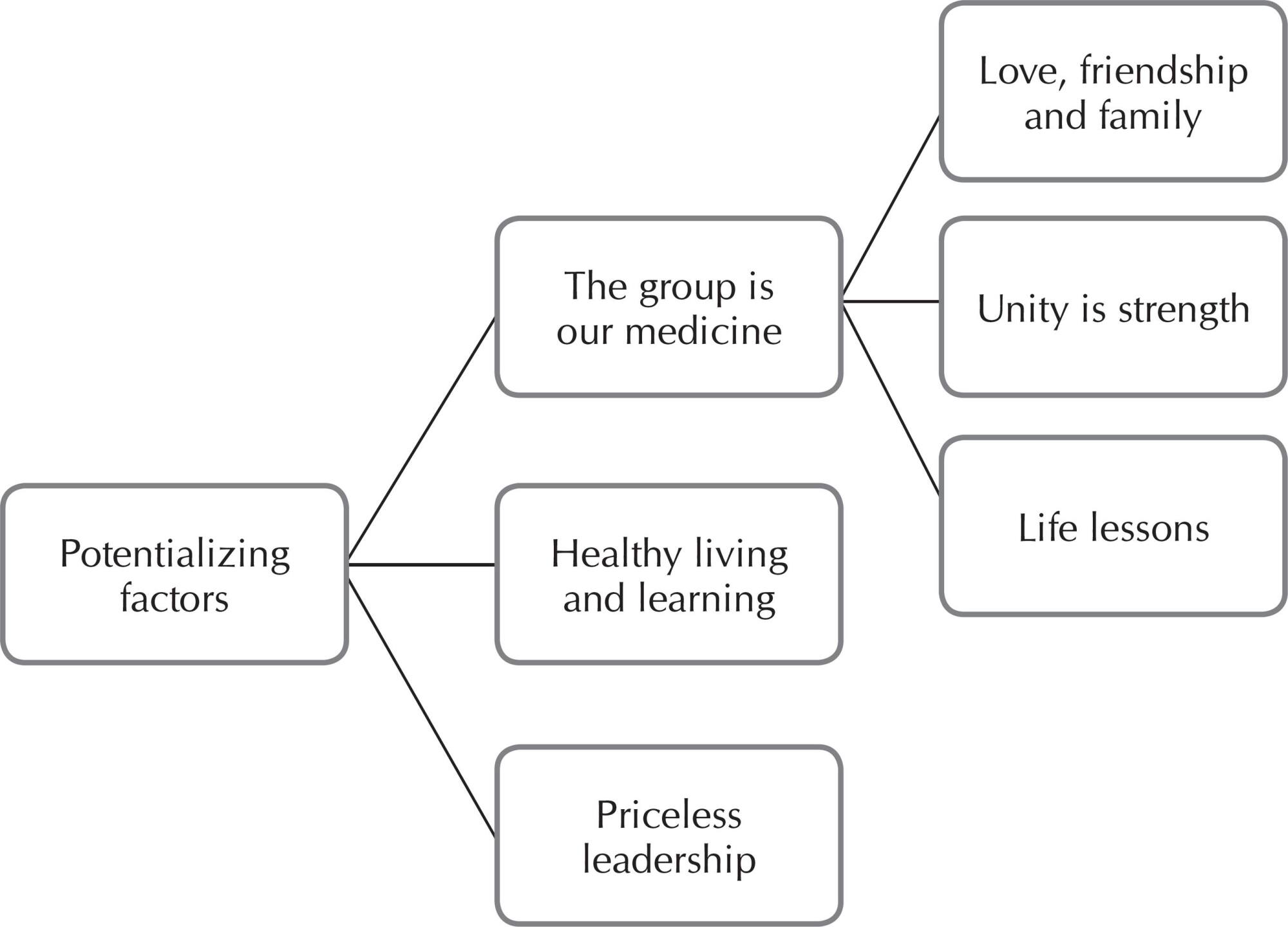
-
01-01-2016
The path to crack addiction: perceptions of people under treatment
Revista Brasileira de Enfermagem. 2016;69(5):956-963
Abstract
The path to crack addiction: perceptions of people under treatment
Revista Brasileira de Enfermagem. 2016;69(5):956-963
DOI 10.1590/0034-7167-2016-0045
Views0See moreABSTRACT
Objective:
the objective of this study was to understand the meaning of the harmful use of crack by people undergoing addiction treatment.
Method:
qualitative approach of social research on strategic modality was used. Field observation, preparation of field diary and focus groups, and data analysis through the method of interpreting meaning were carried out.
Results:
the results contributed to the construction of three thematic categories: “The discovery of crack and other drugs” that describes the experimentation with crack and other drugs; “The pain of the pleasure”, key category that describes the moments after crack experimentation and that, many times, turns into addiction, which leads the person into a cycle of short periods of attempts at abstinence, relapse, and relentless consumption; and “Return to normal life”.
Conclusion:
treating people with crack addiction must be carried out in ways that narrow the distance between these people and their families, society and health care.
-
01-01-2016
Intimate partner violence in adolescence: an analysis of gender and generation
Revista Brasileira de Enfermagem. 2016;69(5):946-955
Abstract
Intimate partner violence in adolescence: an analysis of gender and generation
Revista Brasileira de Enfermagem. 2016;69(5):946-955
DOI 10.1590/0034-7167-2016-0408
Views0See moreABSTRACT
Objective:
to analyze the intimate partner violence in adolescence from the perspective of gender and generation.
Method:
Quantitative, descriptive, and exploratory research. 111 adolescents participated in this study, with ages from 15 to 19 years old.
Results:
We found that 91% of participants have perpetrated and 90.1% have undergone at least one of the natures of violence. The intimate partner violence in adolescence constitutes a form of gender violence, and gender constructions have determined the suffered and perpetrated aggressions, possibly also determining the naturalization and legitimization of such aggressions. The inequality of power between generations may determine greater vulnerability of youngsters to the phenomenon.
Conclusion:
The historical and social construction of masculinity and femininity and the power inequalities set by these constructions converge with the power inequality between generations. Thus, gender and generation are determinants of intimate partner violence in adolescence, as well as of the vulnerability of adolescents to this phenomenon.
-
01-01-2016
Hospitalization anxiety in children: conceptual analysis
Revista Brasileira de Enfermagem. 2016;69(5):940-945
Abstract
Hospitalization anxiety in children: conceptual analysis
Revista Brasileira de Enfermagem. 2016;69(5):940-945
DOI 10.1590/0034-7167-2015-0116
Views0See moreABSTRACT
Objective:
to analyze the concept “hospitalization anxiety in children”, identifying its antecedents, attributes, and consequences, with the objective of clarifying its meaning.
Method:
we used a conceptual analysis model, whose objective is to clarify the meaning of terms.
Results:
we identified the concept antecedents and its attributes, classified as biological and psychological needs, which are essential characteristics of “hospitalization anxiety in children”. This process consequences have also been identified. We proceeded to the analysis of the characteristics with emphasis on the impacts of the hospitalization process on the child and on the family.
Conclusion:
based on the conceptual analysis of the phenomenon, it was possible to identify the antecedents, attributes, and consequences of Hospitalization Anxiety in children. We recommend the continuation of the study validating the essential characteristics presently identified as a way to join knowledge gathered and professional practice.
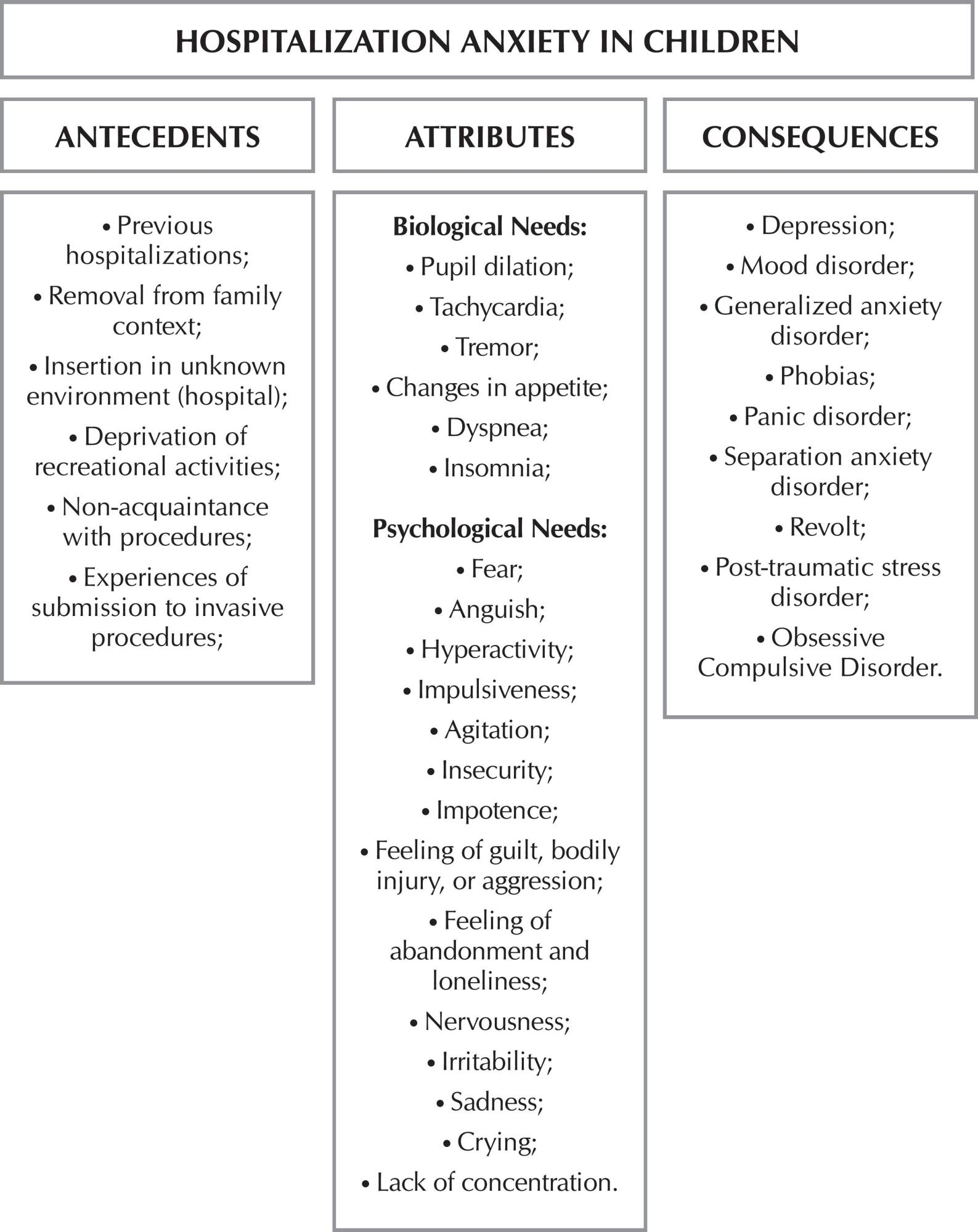
-
01-01-2016
Stroke: patient characteristics and quality of life of caregivers
Revista Brasileira de Enfermagem. 2016;69(5):933-939
Abstract
Stroke: patient characteristics and quality of life of caregivers
Revista Brasileira de Enfermagem. 2016;69(5):933-939
DOI 10.1590/0034-7167-2015-0064
Views0See moreABSTRACT
Objective:
to investigate the association between the domains of health-related quality of life of family caregivers and sociodemographic characteristics of individuals with stroke sequelae.
Method:
descriptive, cross-sectional, quantitative research, conducted with 136 family caregivers of individuals with stroke sequelae by means of home interviews from April to June 2013.
Results:
we found that caregivers of individuals aged under 65 years, married, with 10 to 12 years of formal education, presented higher scores, respectively, in the domains ‘Social aspects’, ‘Emotional aspects’, and ‘Mental health’. However, caregivers of patients with higher degree of disability obtained lower score in the ‘Mental Health’ domain.
Conclusion:
the results foster reflection on the need of including the family caregivers of individuals with stroke sequelae in the planning of care provided by health professionals.
-
01-01-2016
A quasi-experimental nursing study on pain in comatose patients
Revista Brasileira de Enfermagem. 2016;69(5):927-932
Abstract
A quasi-experimental nursing study on pain in comatose patients
Revista Brasileira de Enfermagem. 2016;69(5):927-932
DOI 10.1590/0034-7167-2015-0121
Views0See moreABSTRACT
Objective:
to verify whether comatose patients feel pain during the bed bath nursing procedure.
Method:
nineteen patients aged 61 ± 17.39 years participated in the study. A quantitative analysis was conducted on the P substance (PS) in the saliva collected before and during a bed bath, using the ELISA method. Program Graph Pad Prisma 6 was used to analyze the data. The verification of normality was made through the Shapiro Wilk test, which determined the choice for the Wilcoxon nonparametric test.
Results:
the study showed a statistically significant increase (∆= 5.62%, p<0.001) in the PS level of the patients studied during the nursing procedure.
Conclusion:
when caring for comatose patients during a bed bath, professionals cause or add painful stimuli; therefore, they feel pain.
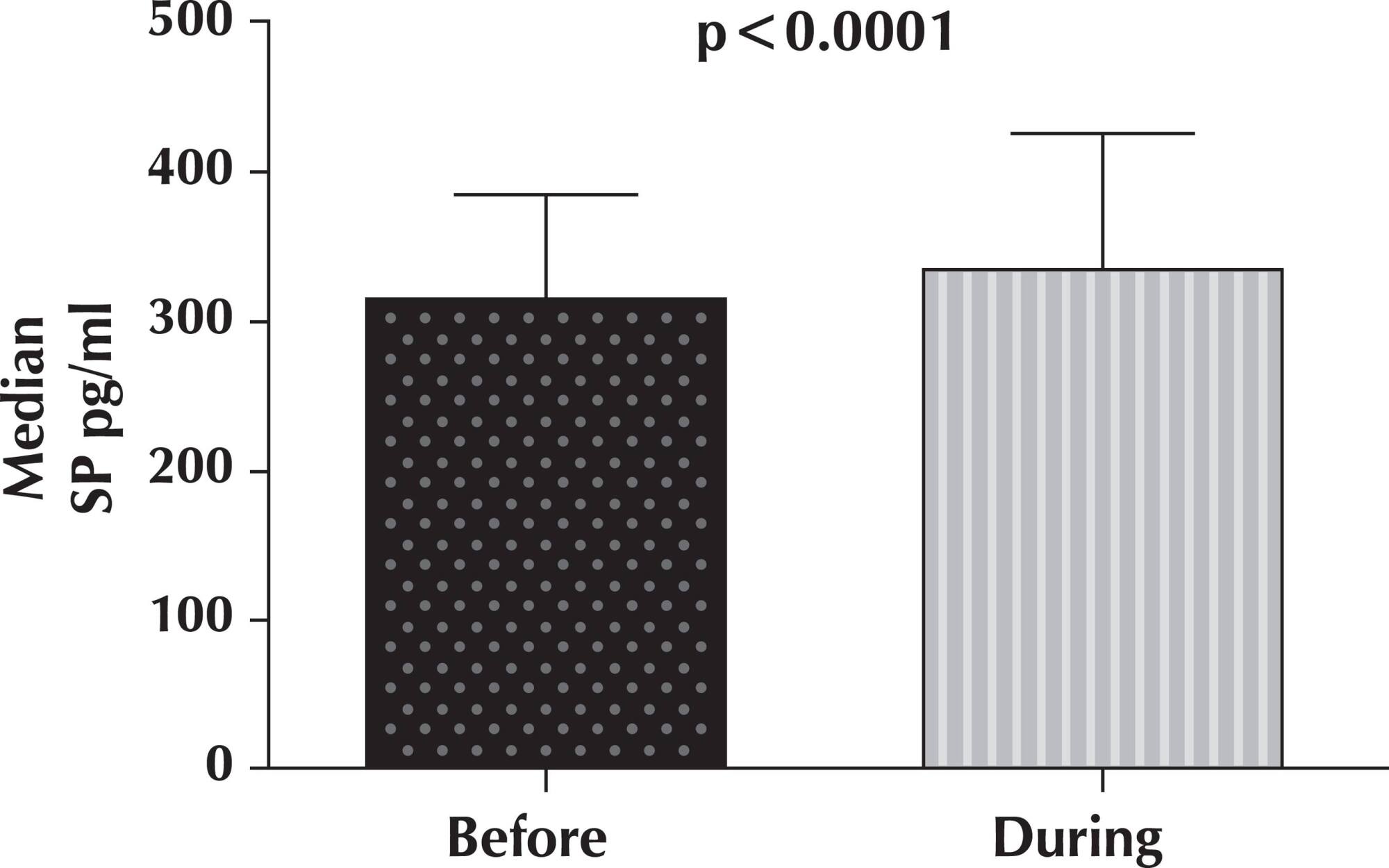
-
01-01-2016
Quality of nursing care: instrument development and validation
Revista Brasileira de Enfermagem. 2016;69(5):920-926
Abstract
Quality of nursing care: instrument development and validation
Revista Brasileira de Enfermagem. 2016;69(5):920-926
DOI 10.1590/0034-7167-2015-0151
Views0See moreABSTRACT
Objectives:
to describe the development and validation process of a scale to measure the nurses’ perception of the activities that contribute to nursing care quality.
Method:
methodological study based on a literature review, the opinion of experts and the experience of study investigators. An instrument was designed containing six dimensions and 25 items, applied as a questionnaire to 775 nurses from a hospital in northern Portugal, from May to July 2014. The instrument validation used an exploratory factor analysis and an internal consistency assessment of each factor/dimension.
Results:
the factor analysis indicated the need to adjust the original composition of the scale, which then received one more dimension, totaling seven dimensions and the same 25 items, and presented a high internal consistency (Cronbach’s alpha of 0.940).
Conclusion:
the final version of the scale presents adequate psychometric properties, with potential use in future studies.
-
01-01-2016
Network and social support in family care of children with diabetes
Revista Brasileira de Enfermagem. 2016;69(5):912-919
Abstract
Network and social support in family care of children with diabetes
Revista Brasileira de Enfermagem. 2016;69(5):912-919
DOI 10.1590/0034-7167-2015-0085
Views0See moreABSTRACT
Objective:
to understand the influence of network and social support in the care of a child with type 1 diabetes.
Method:
qualitative study, with assumptions of ethnonursing, conducted in a reference service specialized in the treatment of diabetes, in 2014, in the city of Fortaleza, state of Ceará, Brazil. Twenty-six members of the family and their respective school children participated in the study. The process of collection and analysis followed the observation-participation-reflection model.
Results:
the analytical categories showed that the social network in the care of children with diabetes helped sharing of information and experiences, moments of relaxation and aid in the acquisition of supplies for treatment, with positive repercussions in the family context, generating well-being and confidence in the care of children with diabetes.
Conclusion:
the cultural care provided by nurses strengthens the network and social support because it encourages autonomy in the promotion of the quality of life of children with type 1 diabetes and their families.
-
ORIGINAL ARTICLE07-14-2021
Impact of the contamination time by Escherichia coli on biofilm formation in surgical instruments
Revista Brasileira de Enfermagem. 2021;74(3):e20200759
Abstract
ORIGINAL ARTICLEImpact of the contamination time by Escherichia coli on biofilm formation in surgical instruments
Revista Brasileira de Enfermagem. 2021;74(3):e20200759
DOI 10.1590/0034-7167-2020-0759
Views1See moreABSTRACT
Objectives:
to evaluate the microbial load and adherence of Escherichia coli in different areas of the surgical instrument surface exposed to experimental contamination over time.
Methods:
experimental study in which fragments of crile forceps (serrated, rod and rack) were contaminated by immersion in Tryptic Soy Broth, containing 106 CFU/mL of E. coli, for 1, 2, 4, 6, 8, 12 and 24 hours. Microbial load and bacterial adherence were evaluated using microbiological culture and scanning electron microscopy, respectively.
Results:
there was an increase in the microbial load on the surgical instrument, proportional to the contamination interval, ranging from 102 after 1 hour to 105 CFU/cm2 in 24 hours. The presence of exopolysaccharide was detected after two hours of contamination.
Conclusions:
microbial load and adhesion of E. coli increased over time, reaching 105 CFU/cm2 after 24 hours of contamination, starting biofilm formation after two hours.
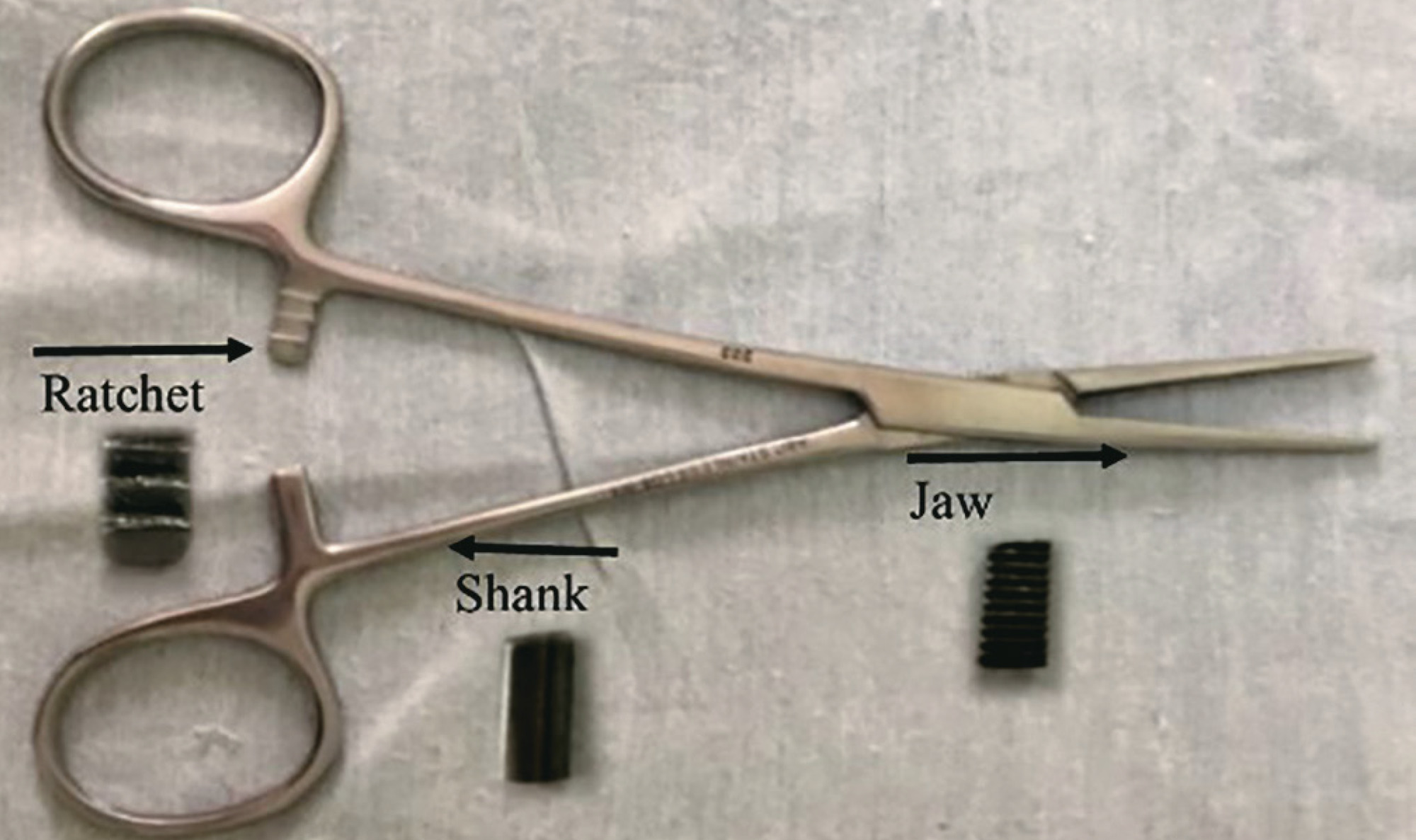
-
REVIEW07-09-2021
Breast cancer screening in Primary Health Care in Brazil: a systematic review
Revista Brasileira de Enfermagem. 2021;74(3):e20200995
Abstract
REVIEWBreast cancer screening in Primary Health Care in Brazil: a systematic review
Revista Brasileira de Enfermagem. 2021;74(3):e20200995
DOI 10.1590/0034-7167-2020-0995
Views1See moreABSTRACT
Objectives:
to analyze care strategies for breast cancer screening in Primary Health Care in Brazil.
Methods:
this is a systematic review following the Cochrane Collaboration recommendations.
Results:
among 355 manuscripts, five were eligible. The patient navigation program by Community Health Agent stood out with the best result, among the strategies: flexibility of goals considering viability; community engagement; team training; active search of the target population by Community Health Agent; request for mammography by physicians; actions integrated to women’s health; monitoring of mammography results, absent users, and population coverage by physician and nurse; and assessment of criteria for requesting screening mammography by means of an information system. The population coverage rate in the program ranged from 23% to 88%.
Conclusions:
Primary Health Care in Brazil presents devices with potential to induce the production of care for breast cancer screening.
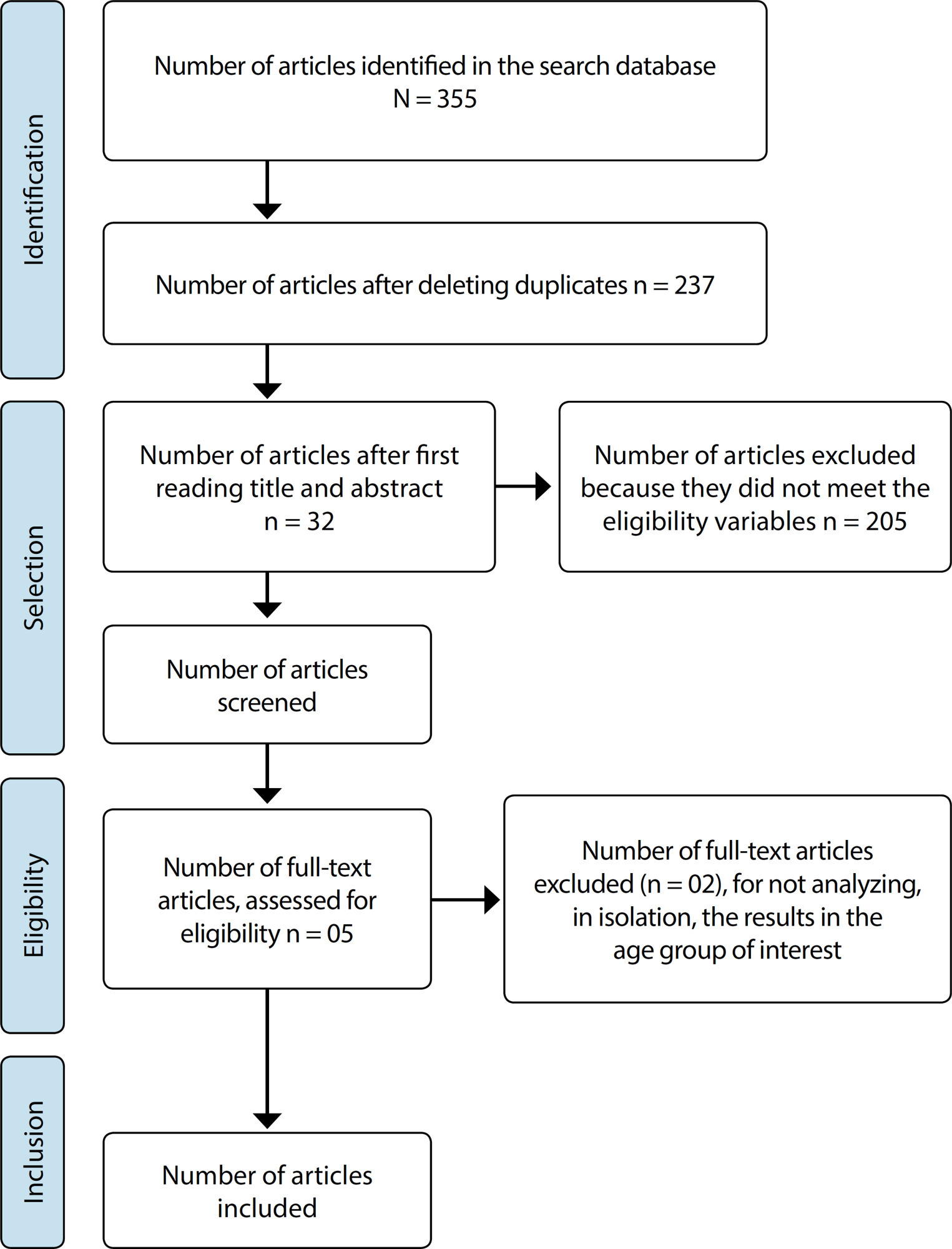
-
ORIGINAL ARTICLE06-18-2021
Spatial-temporal analysis of leprosy in a priority Brazilian northeast municipality for disease control
Revista Brasileira de Enfermagem. 2021;74(3):e20201101
Abstract
ORIGINAL ARTICLESpatial-temporal analysis of leprosy in a priority Brazilian northeast municipality for disease control
Revista Brasileira de Enfermagem. 2021;74(3):e20201101
DOI 10.1590/0034-7167-2020-1101
Views0See moreABSTRACT
Objectives:
to analyze the spatial-temporal distribution of leprosy in a priority municipality for leprosy control.
Methods:
ecological study, conducted in a city in the Northeast of Brazil, whose analysis units were census sectors. The study used compulsory notification data for cases registered between 2008 and 2017. TerraView software and the Batch Geocode tool was used for geocoding. The detection of spatial-temporal agglomerations of high relative risks was done by scanning statistics.
Results:
the spatial-temporal distribution of cases was heterogeneous, creating four agglomerations of high relative risks in the urban area of the municipality between the years 2008 and 2012; and annual prevalence rates classified from high to hyperendemic.
Conclusions:
areas of higher risk and concentration of the disease in space-time were linked to the characteristics of high population density and social vulnerability of these spaces, raising the prioritization of health professionals’ actions, systems, and services for control, and monitoring the disease.
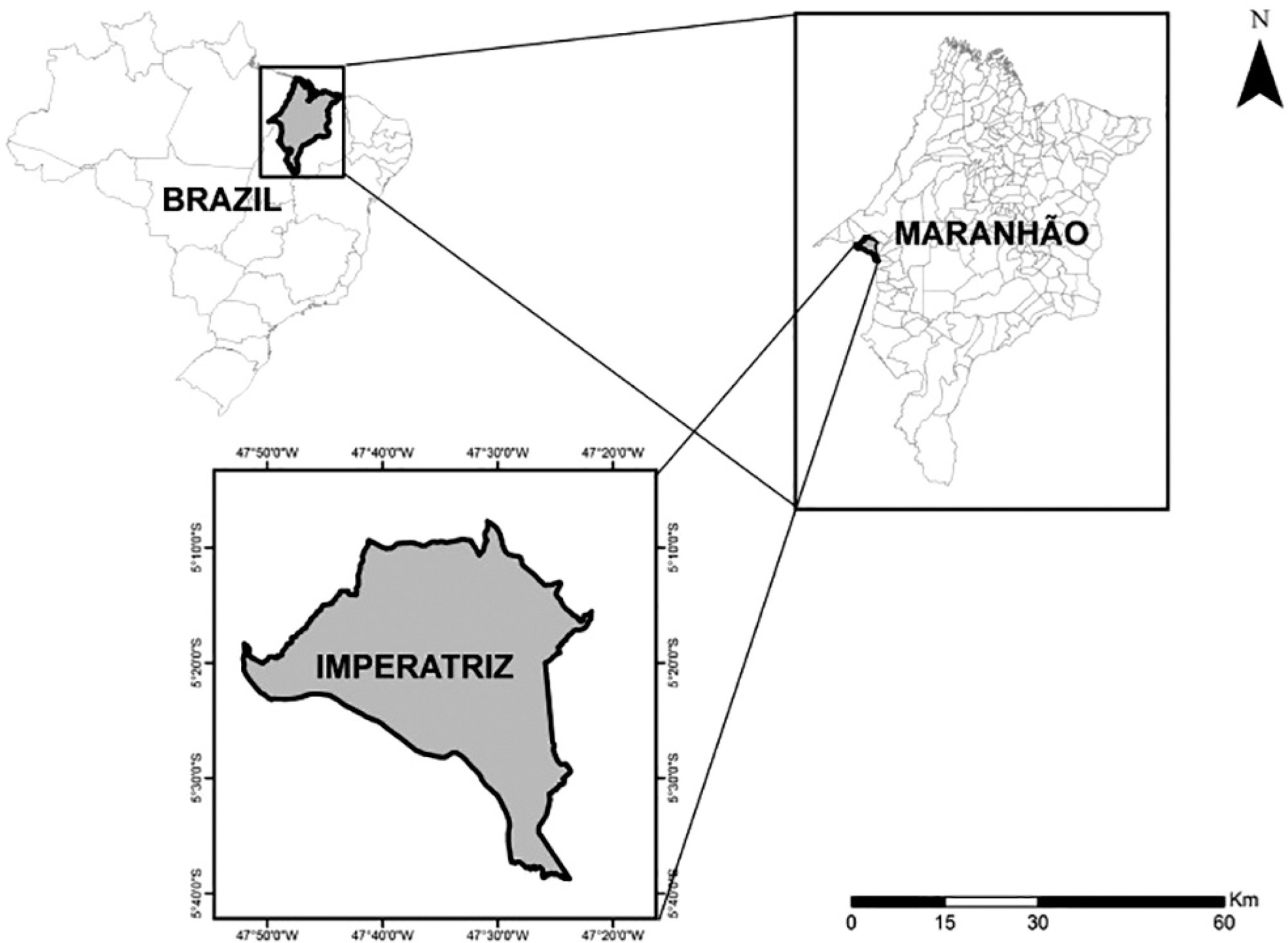
-
ORIGINAL ARTICLE06-18-2021
Assessment of the implementation of a nurse-initiated pain management protocol in the emergency department
Revista Brasileira de Enfermagem. 2021;74(3):e20201303
Abstract
ORIGINAL ARTICLEAssessment of the implementation of a nurse-initiated pain management protocol in the emergency department
Revista Brasileira de Enfermagem. 2021;74(3):e20201303
DOI 10.1590/0034-7167-2020-1303
Views0See moreABSTRACT
Objectives:
to assess the implementation of a nurse-initiated pain management protocol for patients triaged as semi-urgent, and its impact in pain intensity, in the Emergency Department.
Methods:
a prospective cohort study for adult patients with pain who had been triaged as semi-urgent and admitted to the hospital’s Emergency Department. Patients who received the intervention (pain-management protocol with analgesic administration) were compared to those who were managed using the conventional approach (physician evaluation prior to analgesic administration).
Results:
of the 185 patients included, 55 (30%) received the intervention, and 130 (70%) were managed conventionally. Patients in the intervention group were more likely to have taken pain medication in the 4 hours prior to admission, and reported higher levels of pain at admission and more significant reductions in pain level.
Conclusions:
despite low protocol adherence, the intervention resulted in higher reported pain relief.
-
ORIGINAL ARTICLE09-10-2021
Contradicting perceptions of nursing teachers on the neoliberal context of labor
Revista Brasileira de Enfermagem. 2021;74(4):e20200056
Abstract
ORIGINAL ARTICLEContradicting perceptions of nursing teachers on the neoliberal context of labor
Revista Brasileira de Enfermagem. 2021;74(4):e20200056
DOI 10.1590/0034-7167-2020-0056
Views0See moreABSTRACT
Objectives:
To identify and analyze the perceptions of nursing teachers on the new configurations of the job world and the repercussions for their labor activities.
Methods:
Qualitative, descriptive, exploratory research, carried out at two federal nursing colleges in Rio de Janeiro. Data collection occurred with 27 nursing teachers, between May and June 2016, through semi-structured interviews. The data were treated using the thematic content analysis technique.
Results:
The results showed contradictions in the teachers’ perceptions about the job world, which has been guided by neoliberal precepts. Such contradictions are characterized by manifestations in favor of incorporating these precepts, highlighting their negative effects on nursing teaching work.
Final considerations:
There are incongruities in the way of perceiving the current configuration of the job world, proposing more and profound reflections on such a work scenario.
-
ORIGINAL ARTICLE06-04-2021
Association between early pregnant hospitalization and use of obstetric interventions and cesarean: a cross-sectional study
Revista Brasileira de Enfermagem. 2021;74(4):e20200397
Abstract
ORIGINAL ARTICLEAssociation between early pregnant hospitalization and use of obstetric interventions and cesarean: a cross-sectional study
Revista Brasileira de Enfermagem. 2021;74(4):e20200397
DOI 10.1590/0034-7167-2020-0397
Views0See moreABSTRACT
Objective:
Evaluate the association between early pregnant hospitalization and the use of obstetric interventions and cesarean delivery route.
Methods:
Cross-sectional study, with 758 women selected at the time of childbirth. It was assumed as early hospitalization when the woman was admitted to the hospital having less than 6 cm of cervical dilation. Logistic regression models were constructed in order to estimate the odds ratio for each obstetric intervention, adjusted by sociodemographic and obstetric variables.
Results:
73.22% of women were early hospitalized. On average, they had 1.97 times the chance to undergo Kristeller’s maneuver, 2.59 and 1.80 times the chance to receive oxytocin infusion and analgesia, respectively, and 8 times more chances to having their children by cesarean delivery when compared to women that had timely hospitalization.
Conclusion:
Early hospitalized women were submitted to a higher number of obstetric intervention and had increased chances of undergoing cesarean sections.
-
ORIGINAL ARTICLE07-30-2021
Meaning of aging for caregivers of senile elderly people
Revista Brasileira de Enfermagem. 2021;74(4):e20201240
Abstract
ORIGINAL ARTICLEMeaning of aging for caregivers of senile elderly people
Revista Brasileira de Enfermagem. 2021;74(4):e20201240
DOI 10.1590/0034-7167-2020-1240
Views0See moreABSTRACT
Objectives:
to understand the meaning of aging for caregivers of senile elderly people.
Methods:
qualitative study carried out with 12 caregivers of elderly people registered in the Home Care Service, adopting the Explanatory Model of Kleinman’s Disease as a theoretical framework. Data were collected from April to June 2019, through semi-structured, audio-recorded interviews, carried out at home and submitted to content analysis.
Results:
taking care of senile elderly people triggers reflections on aging that sometimes lead to a new meaning of this process, besides stimulating the recognition of the factors that influence it, with emphasis on the life history, occupation and deleterious behaviors adopted throughout life.
Final Considerations:
the care experience influences the meaning attributed to aging, favoring: the identification of modifiable and non-modifiable aspects and behaviors that make it healthy; reflection on aging itself, with a new meaning of habits and behaviors to be adopted.
-
ORIGINAL ARTICLE07-30-2021
Curricular reforms in the transformation of nursing teaching in a federal university
Revista Brasileira de Enfermagem. 2021;74(4):e20201242
Abstract
ORIGINAL ARTICLECurricular reforms in the transformation of nursing teaching in a federal university
Revista Brasileira de Enfermagem. 2021;74(4):e20201242
DOI 10.1590/0034-7167-2020-1242
Views1See moreABSTRACT
Objectives:
to discuss the curricular reforms adopted for nursing teaching in Brazil, from 1969 to 2019.
Methods:
historical, qualitative approach using the thematic oral history and document research. 13 interviews were carried out with graduation nursing professors from a federal university in the South of Brazil. The document sources were the political-pedagogical projects of the course and their associated documents. Minayo’s thematic analysis was used.
Results:
nursing curricula delineates the profile of the professional that must be formed and are reviewed in order to be adapted to social and educational changes, showing the scientific and professional potential of the nurse. Curricular reforms consider the quality of nursing formation.
Final Considerations:
the structure of the curriculum and the reforms that took place emerged according to the historical, political, epidemiological and social context demanded from the profession, to attend to the demands of society and to the work market.
-
REVIEW09-18-2020
Allocation of resources for health care in COVID-19 pandemic times: integrative review
Revista Brasileira de Enfermagem. 2020;73:e20200244
Abstract
REVIEWAllocation of resources for health care in COVID-19 pandemic times: integrative review
Revista Brasileira de Enfermagem. 2020;73:e20200244
DOI 10.1590/0034-7167-2020-0244
Views0See moreABSTRACT
Objective:
To analyze information on resource allocation in the context of the COVID-19 pandemic, published in indexed scientific journals, from December 2019 to March 2020.
Methods:
This is an integrative literature review, which took place in March 2020. All databases were investigated and studies were found only in MEDLINE. After applying the established criteria, six articles were selected.
Results:
It was evident that the allocation of resources is carried out as the demands emerge. The fragility in presenting scientific-methodological evidence that can guide decision makers for assertive allocation of available resources is highlighted. The results showed that studies on this subject are incipient and need to be expanded.
Final considerations:
The need for health organizations and area authorities to be better prepared for the proper use of available resources, with allocation based on scientific evidence and maximization of resources is indicated.
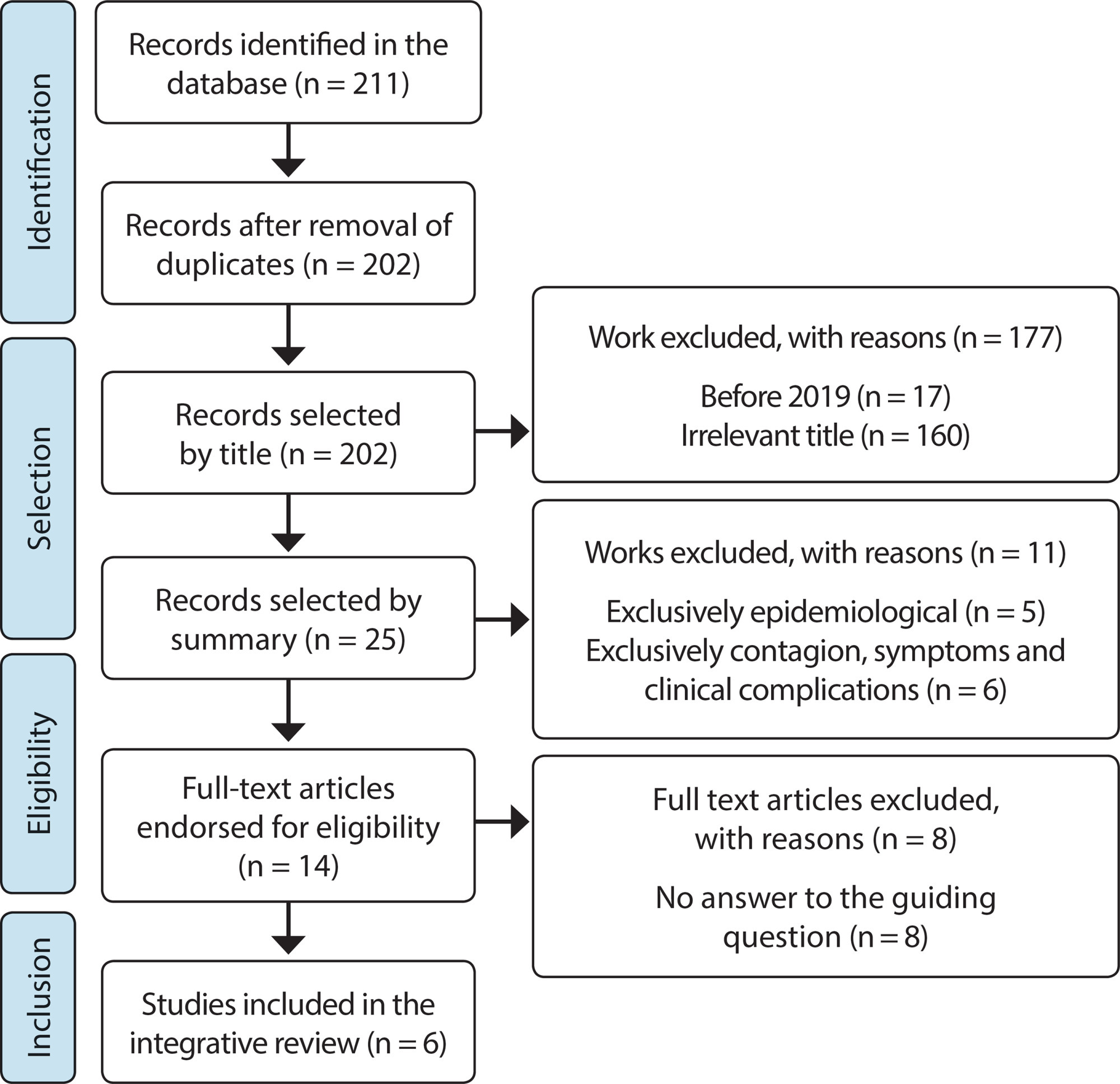
-
ORIGINAL ARTICLE02-10-2020
Mobile care service for psychiatric urgencies and emergencies: perception of nursing workers
Revista Brasileira de Enfermagem. 2020;73(1):e20180214
Abstract
ORIGINAL ARTICLEMobile care service for psychiatric urgencies and emergencies: perception of nursing workers
Revista Brasileira de Enfermagem. 2020;73(1):e20180214
DOI 10.1590/0034-7167-2018-0214
Views0See moreABSTRACT
Objective:
To understand how the nursing staff perceives the care provided to people in situations of psychiatric urgencies and emergencies in the Mobile Emergency Care Service (SAMU – Serviço de Atendimento Móvel de Urgência).
Method:
Descriptive and qualitative study conducted in the Northeast region of Brazil with 34 of the SAMU nursing workers. Data were obtained by semi-structured interviews and processed by the Thematic Analysis.
Results:
The analysis of interviews allowed the identification of three categories: mechanical practice, need for qualification and (de)humanization of care. The results showed that the care offered to users in psychiatric urgency or emergency situations is based on mechanistic and specific actions.
Final considerations:
Nursing workers perceive that the care for people in situations of psychiatric urgency and emergency in SAMU is mainly based on physical and chemical containment measures, performing a little resolute and dehumanized care and raising the need for professional qualification.
-
ORIGINAL ARTICLE09-16-2019
Playful educational intervention with schoolchildren on intestinal parasitosis
Revista Brasileira de Enfermagem. 2019;72(5):1203-1210
Abstract
ORIGINAL ARTICLEPlayful educational intervention with schoolchildren on intestinal parasitosis
Revista Brasileira de Enfermagem. 2019;72(5):1203-1210
DOI 10.1590/0034-7167-2017-0551
Views0See moreABSTRACT
Objective:
To analyze the playful educational interventions in the knowledge of schoolchildren about intestinal parasitosis.
Method:
This is a quasi-experimental, non-randomized study, based on pre- and post-intervention, conducted in a public elementary school in a peripheric neighborhood in the city of Ribeirão Preto (SP). The study population consisted of 101 students enrolled in the 5th and 6th grade. For comparison, we used the generalized version of the McNemar chi-squared test.
Results:
Of the 101 schoolchildren who participated in the study, 48 (47.5%) were female and 53 (52.5%) were male, aged from 9 to 14 years. Students’ knowledge on intestinal parasitic infections has increased significantly after the playful educational intervention.
Conclusion:
Playful educational interventions are an excellent didactical resource in the teaching-learning process of schoolchildren.
-
REFLECTION07-10-2020
In defense of the Unified Health System in the context of SARS-CoV-2 pandemic
Revista Brasileira de Enfermagem. 2020;73:e20200247
Abstract
REFLECTIONIn defense of the Unified Health System in the context of SARS-CoV-2 pandemic
Revista Brasileira de Enfermagem. 2020;73:e20200247
DOI 10.1590/0034-7167-2020-0247
Views0See moreABSTRACT
Objective:
To discuss the political and structural conditions for establishing the Unified Health System (UHS – Sistema Único de Saúde, SUS) in coping with the SARS-CoV-2 pandemic.
Methods:
Theoretical-reflection study.
Results:
At the first moment named “The global and the local in facing the SARS-CoV-2 pandemic” is presented the health crisis that took place worldwide and the government actions to combat COVID-19. A second moment named “Between dismantling actions and resistance, the UHS is the best way to face the SARS-CoV-2 pandemic”, reflects on the neoliberal attacks on the health system and how it resists, remaining the main pandemic response strategy.
Conclusion:
The strengthening of democracy and the defense of the UHS are the way out of the crisis. It is believed that this reflection generates – in everyone who deals with caretaking – the political action, the ethical attitude, the desire for valorization and the spirit of struggle in defense of the UHS and human life.
-
ORIGINAL ARTICLE08-19-2019
Psychosocial risks related to the nurse in the psychiatric hospital and management strategies
Revista Brasileira de Enfermagem. 2019;72(4):834-840
Abstract
ORIGINAL ARTICLEPsychosocial risks related to the nurse in the psychiatric hospital and management strategies
Revista Brasileira de Enfermagem. 2019;72(4):834-840
DOI 10.1590/0034-7167-2017-0311
Views0See moreABSTRACT
Objective:
To characterize the presence of psychosocial risks related to the work of the nurse in a psychiatric hospital and the strategies for managing these risks.
Methods:
Qualitative, in which 25 nurses from a psychiatric hospital participated using semi-structured interviews from November 2014 to January 2015. Data analysis was performed using the thematic method.
Results:
The results showed psychosocial risks related to the work of psychiatric nurses, such as: insufficient academic training; lack of preparation and maintenance of equipment; poor relationship with colleagues; shortage of human resources and lack of capacity building; conflict between the demands of the home and work, as well as strategies for managing psychosocial risks such as family, cinema, music, reading, among others.
Final considerations:
This study should provoke the reflection of managers and future nurses regarding the working conditions in a psychiatric hospital and possible psychosocial risks to which they are exposed.
-
ORIGINAL ARTICLE03-30-2020
Implication of the training ad continuing education process for the interprofessional performance
Revista Brasileira de Enfermagem. 2020;73(2):e20180359
Abstract
ORIGINAL ARTICLEImplication of the training ad continuing education process for the interprofessional performance
Revista Brasileira de Enfermagem. 2020;73(2):e20180359
DOI 10.1590/0034-7167-2018-0359
Views0See moreABSTRACT
Objetives:
to analyze the implication of the training/continuing education process of professionals of the Expanded Nucleus of Family Health and Basic Care (Portuguese acronym: Nasf-AB) for their interprofessional performance.
Methods:
a qualitative case study performed with Nasf-AB teams representative of four macro-regions of health of the state of Santa Catarina. Participation of 43 professionals, who answered collective interviews. The results were later submitted to thematic analysis.
Results:
the training is strongly influenced by the Biomedical Model, which acts as an obstacle to interprofessional performance, given the challenges in the daily routine of Nasf-AB professionals. Continuing education emerges as a potential for the successful collaborative work among teams, and between the teams and Family Health professionals.
Final considerations:
there are important limits in the training of professionals. However, the constant interprofessional development promoted by strategies of continuing education contributes to broaden the support and collaborative practices that qualify services and strengthen Basic Care.
-
ORIGINAL ARTICLE02-25-2022
Diabetes mellitus type 2: factors related to adherence to self-care
Revista Brasileira de Enfermagem. 2022;75(4):e20210260
Abstract
ORIGINAL ARTICLEDiabetes mellitus type 2: factors related to adherence to self-care
Revista Brasileira de Enfermagem. 2022;75(4):e20210260
DOI 10.1590/0034-7167-2021-0260
Views0See moreABSTRACT
Objectives:
to analyze the sociodemographic and clinical variables related to the adherence to self-care activities in people with diabetes mellitus type 2.
Methods:
quantitative, cross-sectional study, carried out with 270 people with diabetes from December 2019 to October 2020, in São Luís, Maranhão.
Results:
the adherence to self-care was greater when it comes to medications (Md=7.0) and foot care (Md= 6.0), but lower in regard to blood sugar testing (Md=1.0), exercise (Md=2,0), and diet (general) (Md=4.0). The variables age group (p=0.007), educational level (p=0.015), body mass index (p=0.035), complications with diabetes (p=0.009), and nutritional follow-up (p=0.000) had associations with self-care activities.
Conclusions:
identifying the factors related to the adherence to self-care was found to be essential to strengthen the line of care in chronic diseases and to direct educational actions, aiming to improve the quality of life of people with diabetes.
-
ORIGINAL ARTICLE12-04-2020
“The pen is the blade, my skin the paper”: risk factors for self-injury in adolescents
Revista Brasileira de Enfermagem. 2020;73:e20200578
Abstract
ORIGINAL ARTICLE“The pen is the blade, my skin the paper”: risk factors for self-injury in adolescents
Revista Brasileira de Enfermagem. 2020;73:e20200578
DOI 10.1590/0034-7167-2020-0578
Views0See moreABSTRACT
Objective:
to describe the risk factors that influence the self-injury behavior of adolescents assisted at a Psychosocial Care Center for Children and Adolescents, according to subjects’ own perceptions.
Method:
a descriptive, exploratory, qualitative study carried out through medical records and a focus group with 07 adolescents. The statements were submitted to thematic content analysis.
Results:
in the risk factors category, four subcategories emerged: Family adversity factors; Social contagion; Adverse life events; Personal characteristics. Conflicts, lack of support, drug use in the family, meeting someone who cuts themselves, social networks, religiosity, history of sexual violence and bullying were identified as risk factors that influence self-injury.
Final Considerations:
adolescents pointed out the need for prejudice-free dialogues in schools, in health and family devices, configuring protective factors to avoid this practice that comes from several negative events throughout life.

Search
Search in:
Nuvem de Tags
Adolescente (85) Atenção Primária à Saúde (239) COVID-19 (91) Criança (91) Cuidados de Enfermagem (269) Educação em Enfermagem (151) Educação em Saúde (139) Enfermagem (930) Enfermagem Pediátrica (86) Estudantes de Enfermagem (77) Estudos de Validação (131) Família (87) Idoso (208) Promoção da Saúde (99) Qualidade de Vida (104) Saúde do Trabalhador (86) Saúde Mental (145) Saúde Pública (82) Segurança do Paciente (150) Tecnologia Educacional (100)



